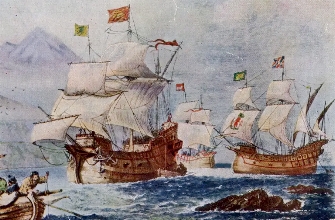  Ferdinand Magellan set out from Spain in 1519 with a fleet of five ships to discover a western sea route to the Spice Islands, a small group of islands now called the Moluccas in Indonesia.
Ferdinand Magellan set out from Spain in 1519 with a fleet of five ships to discover a western sea route to the Spice Islands, a small group of islands now called the Moluccas in Indonesia. In the 16th century, spices were at the centre of the world's economy, much like oil is today. Highly valued for flavouring and preserving food as well as masking the taste of meat gone bad, spices like cinnamon, clove, nutmeg and especially black pepper were extremely valuable. Since spices could not be grown in colder, drier Europe, no effort was spared to discover the quickest sea route to the Spice Islands. Along the way he discovered what is now known as the Strait of Magellan, a stormy, treacherous patch of water south of South America that led to the Pacific.  Magellan's Voyage Around the World Magellan became the first European to see and to cross the Pacific Ocean, a long, dangerous voyage that itself took over three months. In fact, only one of his ships managed to return home three years later, after storms, several mutinies and desertions. Despite being laden with valuable spices from the East, only 18 of the fleetís original crew of 270 returned with the ship. Magellan himself was killed in battle near the Philippines.  Europeans had reached the Spice Islands previously, by sailing east and south around the bottom of Africa, but none had attempted to make the trip westward to reach the other side of the world. Magellan's expedition proved that the globe could be circled by sea, and that the world was much larger than had previously been thught.
Europeans had reached the Spice Islands previously, by sailing east and south around the bottom of Africa, but none had attempted to make the trip westward to reach the other side of the world. Magellan's expedition proved that the globe could be circled by sea, and that the world was much larger than had previously been thught. European geographic knowledge was expanded immeasurably by Magellanís expedition. He found not only a massive ocean, previously unknown to Europeans, but he also discovered that the earth was much larger than previously thought. Finally, although it was no longer believed that the earth was flat at this stage in history, Magellanís circumnavigation of the globe empirically discredited that medieval theory conclusively. |